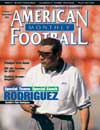AMERICAN FOOTBALL MONTHLY THE #1 RESOURCE FOR FOOTBALL COACHES
Article CategoriesAFM Magazine
|
State of EmergenceOregon is now home to two of the Nation\'s fastest rising and best programsby: Ron Bellamy © More from this issue A huge photograph of a college quarterback appears, mural-like, on the side of a building across from Madison Square Garden in New York City during the past summer, touting the senior's candidacy for the Hesiman Trophy. Two of his teammates will appear this season on promotional billboards in San Francisco and Los Angeles. You think: Notre Dame, maybe? At the rival school up the road, they're hyping the star running back for the Heisman Trophy. They pose him in a photo with a prominent alum who, it just so happens, also won college football's most prestigious award. You think: Southern California, for sure. For $600,000 each, the two rivals have agreed to move their annual battle to the first weekend in December, for a national ABC telecast on a day that will be billed as "Championship Saturday." You think: Nebraska vs. Okl....The full article can only be seen by subscribers.
|
|
|||||||
| HOME |
MAGAZINE |
SUBSCRIBE | ONLINE COLUMNISTS | COACHING VIDEOS |
Copyright 2025, AmericanFootballMonthly.com
All Rights Reserved





